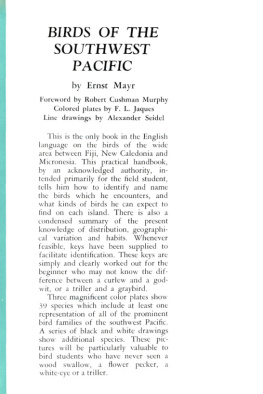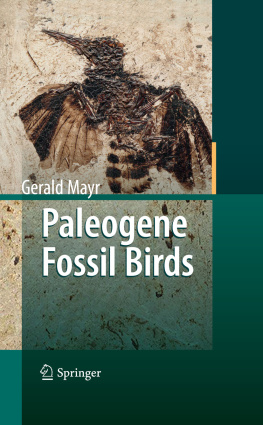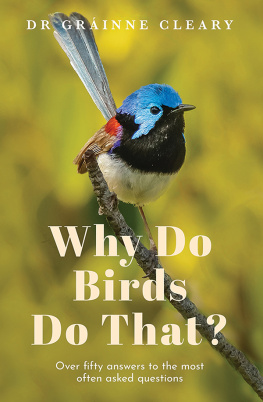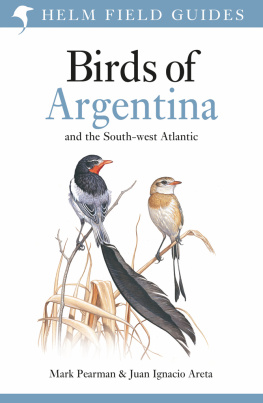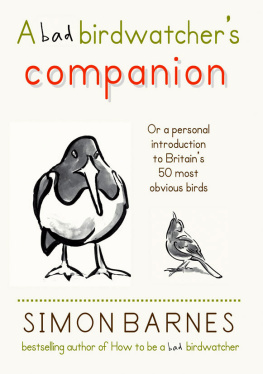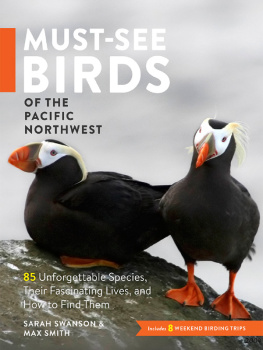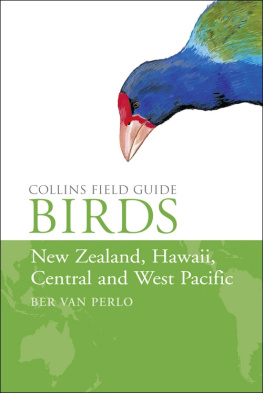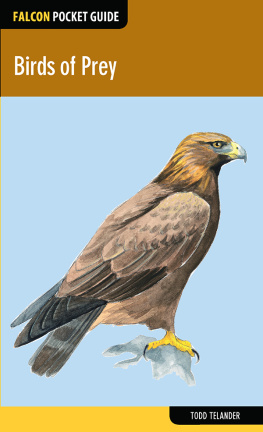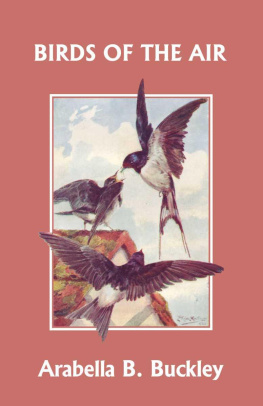I
The Seabirds of the Southwest Pacific
T ERNS are the dominant seabirds of this region. Aside from them the oceanic bird life is remarkably poor in variety of resident species. Penguins, skimmers, pelicans, and marine cormorants are entirely absent. The order of Tubinares, which includes albatrosses, shearwaters, petrels, and Mother Carey's chickens, is represented by a few resident species and some additional regular visitors, while many others barely reach the southern edge near New Caledonia or the northern edge near the Marianas during their far-flung wanderings between breeding seasons. It is impossible to enumerate and describe all such accidental visitors in this short guide. Bird students who are especially interested in seabirds should consult W. B. Alexander's Birds of the Ocean (Putnam, 1928). The subsequent discussion of seabirds leans heavily on this volume.
Our knowledge of the seabirds of the Pacific (their relationships, distribution, and life histories) is still very incomplete. Field students can make significant contributions by recording the situation of breeding colonies, the breeding seasons of each species at a given locality, and the wanderings of nonbreeding birds between seasons.
TUBE-NOSED SWIMMERS ORDER TUBINARES OR PROCELLARIIFORMES
In spite of a slight superficial resemblance, these oceanic birds are not related to the gulls. The Tubinares arc a very distinct and rather homogeneous group. They are excellent fliers and spend most of their time on the open ocean. Most of them nest colonially, and many of them in self-excavated burrows. All species lay only a single egg. The incubation and fledging periods are extraordinarily long. The size difference between the smallest petrels (Mother Carey's chickens) and the largest albatrosses is unique among orders of birds. The waters of the southern hemisphere are the headquarters of this order, but a number of species occur north of the equator, particularly in the Pacific. There are only a few tropical species.
ALBATROSSES (FAMILY DIOMEDEIDAE)
Albatrosses are typically birds of cold waters, but they reach the S.W.P. from the north and occasionally from the south. Three species are known from the North Pacific and all 3 occur probably in Micronesia. Most albatrosses breed in colonies, their nests with single eggs being on the ground.
Key to North Pacific Albatrosses
(1) Head and body white ............................... 2
Head and body brown or sooty .................. 3
(2) Whole body including middle of back white; top of head buffy; wing tips and tail tips brown; bill pinkish; feet bluish white ................ albatrus (adult)
Head, body, and rump white; back, wings, and end of tail sooty brown; bill gray; feet fleshy pink .................................................... immutabilis
(3) Chocolate brown; bill pinkish; feet flesh color ...................................................................... albatrus (young)
Sooty brown; area around bill whitish; bill dark reddish brown; feet black ...................................................................................... nigripes
Short-tailed Albatross (Diomedea albatrus Pallas): Ranged formerly through the entire North Pacific. Bred on Wake Isl. and on the Bonin Isls. Now nearly extinct. Eggs have been found from August to December.
Laysan Albatross (Diomedea immutabilis Rothschild): In the central North Pacific. Breeds on the islands west of Hawaii (Midway, Laysan, etc.). Young similar to adults. Wingspread 6' 8".
Black-footed Albatross (Diomedea nigripes Audubon): This species also called the Gooney, is the most common albatross of the North Pacific. Breeds on the islands northwest of Hawaii, Midway Isl., Marshall Isls., Volcano Isl., and Bonin Isls. Young similar to adults, but have more white on the head and rump.
Two species of South Pacific albatrosses occasionally reach the waters along the southern edge of the S.W.P. Adults and immatures are very different in one of these species (exulans), while there are no pronounced sexual or age differences in the other one (epomophora).
Key to Southwest Pacific Albatrosses
(1) Underparts and middle of back more or less brown; face and underside of wing white ................ D. exulans (juv.)
Underparts more or less white ................ 2
(2) Tail all white; body always entirely white; wing usually rather solid blackish brown ................ D. epomophora
Tail dark or tipped with black; body often mottled with black wavy lines. Inner wing frequently with much white ................ D. exulans
Wandering Albatross (Diomedea exulans L.): Females usually have a dark brown cap. Nests on the islands south of New Zealand. Wanders north to about 20S.
Royal Albatross (Diomedea epomophora sanfordi Murphy): Nests on the Chatham Isls. and in other parts of the New Zealand region. Wanders north to about 20S.
PETRELS AND SHEARWATERS (FAMILY PROCELLARIIDAE, PROCELLARIINAE)
There is probably no other family of birds that causes more difficulties to the field observer. Even experienced students enter in their notebooks as unidentified most of the individuals of this family that they encounter in the waters of the South Pacific. The beginner should not feel too much discouraged if he experiences similar difficulties. The situation is aggravated by the fact that several species have both a white-bellied and a dark-bellied color phase.
Members of this family are somewhat gull-like in appearance, but their flight is very different and quite diagnostic. They skim over the wateron windy days gliding rapidly without flapping their wings. The body is usually tilted, with one wing almost touching the water ("shearwater"), while the other points skyward. In tropical waters entire days sometimes pass without a shearwater coming into sight, but when a squall darkens the sky and roughens the water, a flock of them may suddenly appear from nowhere, zigzagging across the water, and disappear just as mysteriously. The native shearwaters of the S.W.P. are still very poorly understood. Many of them are known only from 2 or 3 specimens. In addition the area they inhabit is visited, between breeding seasons, by many of the species that breed in south Australian or New Zealand waters.

FIG. 2. Bill of Pterodroma r. rostrata (top) and of Puffinus p. pacificus (bottom). The bill of a typical petrel (Pterodroma) is short and thick, that of a shearwater (Puffinus) longer and more slender.
Shearwaters nest in colonies, usually in holes in the ground. Females and immatures do not differ from the males in coloration. Shearwaters, as compared to petrels, are on the whole characterized by their flattened "legs" (tarsi), their more slender bills, greater ability to dive, and greater tendency to congregate in flocks, both when resting on the water and in flight. This distinction between the 2 groups is, however, by no means diagnostic.
Key to the Shearwaters and Petrels
(1) Plumage dark or black ............................................... Section A
(2) Plumage dark above, white underneath ................................ Section B
(3) Upperparts, throat, and foreneck dark; abdomen white ................ Section C
(4) Upperparts sooty black; underparts white with a dark band across the breast ................ Section D
Section A
This includes about 7 species, found in the S.W.P.
Wedge-tailed Shearwater (Puffinus pacificus Gmelin): A dark, large (15-17) shearwater with a rather long, wedge-shaped tail and pale feet. Upperparts dark chocolate brown; face and throat dark brownish gray; rest of underparts grayish brown; underwing dusky. Bill bluish or black; feet yellowish fleshcolor or whitish. Has a white-bellied phase (see below).

